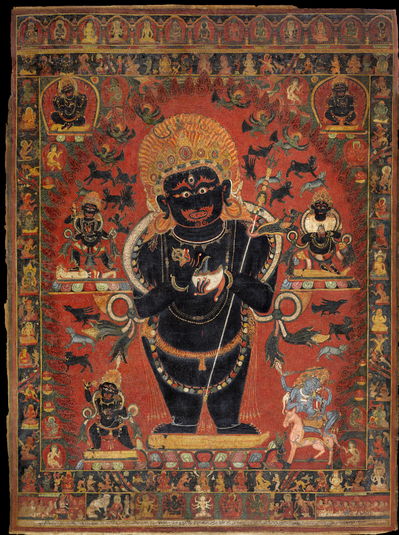
Item: Mahakala (Buddhist Protector) - Panjarnata (Lord of the Pavilion)
| Origin Location | Nepal |
|---|---|
| Date Range | 1500 - 1599 |
| Lineages | Sakya and Buddhist |
| Size | 113x83.80cm (44.49x32.99in) |
| Material | Ground Mineral Pigment on Cotton |
| Collection | Private |
Panjarnata Mahakala of the Arya Tradition (dated by inscription to 1543).
Videos: - A Powerful Painting of Mahakala - Panjarnata Mahakala
"...the great Vajra Mahakala, blazing, with one face, two hands, in the right a curved knife and the left a skullcup filled with blood, held above and below the heart. Held across the middle of the two arms is the 'Gandhi of Emanation.' With three eyes, bared fangs, yellow hair flowing upward, a crown of five dry human skulls and a necklace of fifty wet, blood dripping; adorned with six bone ornaments and snakes; having a lower garment of tiger skin; flowing with pendants and streamers of various silks; in a posture dwarfish and thick, standing above a corpse. To the right is a black crow, left a black dog, behind a wolf, in front a black man, above a garuda, emanations of messengers issue forth, with Akshobhya as a crown, standing in the middle of a blazing fire of pristine awareness." (Konchog Lhundrub, 1497-1557).
The description above is for a slightly different form of Panjarnata but many of the principal characteristics are the same. Numerous animals, garudas, wolves, dogs, jackals, ravens and crows, either black or dark in colour, emanate as messengers from the body of Mahakala.
Above the central figure, at the left is Chaturbhuja Mahakala with one face and four arms, seated. At the upper right is Panjarnata Mahakala holding a 'gandhi' staff and in a squatting posture with the legs bent at the knees. To the left of the central figure is Bhutadamara Vajrapani. At the right side is Ekajati. At the lower left is Copper Knife Mahakala. On the right side is Shri Devi, light blue in colour, with four arms and riding a donkey.
At the sides, above and below, is a thin square register containing the Eight Great Cemeteries: "In the east is the Gruesome charnel ground (chandograkatasi); south Frightful with Skulls (bhairavakapalika); west Adorned with a Blazing Garland (jvalamalalankara); north Dense Jungle (girigahvaronnati); north-east Fiercely Resounding (ugropanyasa); south-east Forest of the Lord (ishvaravana); south-west Dark and Terrible (bhairavandhakara); north-west Resounding with the Cries Kili Kili (Kilikilaghoshanadita). Furthermore, there are headless corpses, hanging corpses, lying corpses, stake-impaled corpses, heads, skeletons, jackals, crows, owls, vultures, and zombies making the sound, "phaim". There are also siddha with clear understanding, yaksha, raksha, preta, flesh eaters, lunatics, bhairava, daka, dakini, ponds, fires, stupa, and sadhaka. All of these fill the charnel grounds." (Konchog Lhundrub 1497-1557, written in 1551).
In the top register beginning at the far right side is Vajrasattva, Vajradhara, Manjushri, Ushnishavijaya, Ratnasambhava, Vairochana, Akshobhya, Amitabha, Amoghasiddhi, Chaturbhuja Lokeshvara, Maitreya, Green Tara and Kneeling Achala.
At the bottom left side is a Vajracharya priest performing a fire ritual. Seated behind are four donor figures. At the right side are additional donor figures likely to be additional family members related to the figures at the far left side. In the center of the lower register are the Pancha Raksha female deities of auspiciousness, five in number. Situated to the right and left of the five goddesses are the Seven Jewels of Royal Power: 1. Wheel, 2. Jewel (atop the elephant), 3. Queen, 4. Minister, 5. Elephant, 6. Horse, 7. General.
Jeff Watt [updated 4-2023]
Provenance: Nasli and Alice Heeramaneck Collection, New York, 1960’s Christian Humann (Pan-Asian Collection), 1974-1982 Robert Hatfield Ellsworth, New York, 1982-1993 European Private Collection Published: Pratapaditya Pal, The Arts of Nepal, Volume Two: Painting, Leiden, 1978, pp. 83 and 84, no. 102
Mahakala: Boethang Gonpo Statue
Mahakala: Panjarnata, Lord of the Pavilion (Main Page)
Publication: Art of Tibet-Asia House Gallery (Painting)
Mahakala: Panjarnata (Arya Tradition)
Mahakala: Panjarnata, Arya Tradition (with Katvanga)
Mahakala: Panjarnata (Tundikhel)
Mahakala: Panjarnata Masterworks (Painting & Textile)

